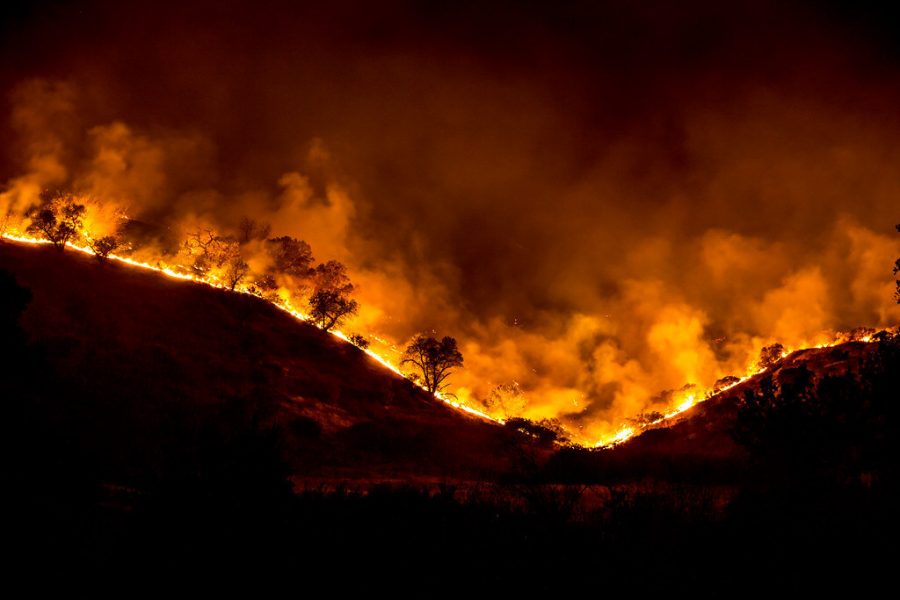California fires remain uncontained as they spread over 1 million acres
Forest Service, USDA | Flickr
October 9, 2020
Since August, forest fires have ravaged northern California and have killed 24 people. As the fire spreads across 1 million acres, it has become one of the biggest wildfires in California’s history.
So far around 64,000 people have had to evacuate California. The air quality is poor due to the buildup of smoke and the smoke is so prolific that it spread from the west coast to the east coast and could be seen in New York.
As the skies turn orange, people are seeing proof that climate change is real. “The debate is over, around climate change,” California Gov. Gavin Newsom told reporters. “This is a climate damn emergency. This is real and it’s happening.”
To understand how the fires started, one must consider a combination of occurrences caused by both humans and nature. In terms of nature, the trees were initially struck by lightning, causing the fires. Simultaneously, California has faced an increase in temperatures due to global warming.
As carbon dioxide is emitted into the air, it eats away at the ozone layer. This allows more sunlight to pass through which ultimately leads to an increase in temperature. For decades, humans have participated in activities that increase carbon dioxide emissions, such as burning fossil fuels.
Instead of heeding the warnings of climate experts and scientists, humans have only fueled global warming, resulting in an increase of destructive natural disasters, from hurricanes to fires.
“In California, a prolonged drought over the past decade has killed millions of trees, turning them into potent fuel for the fires. Mountain regions that are normally cooler and wetter have dried out more rapidly in the summer, adding to the potential fuel load,” according to BBC News.
Combine these high temperatures and drier areas filled with oxygen from trees, and a forest becomes a matchbox able to be kindled at any moment. Add lightning to that mix and large, uncontainable fires break out. Lightning was the initial cause of the fires but factors caused by global warming only exacerbated the burning.
On top of that, a tropical storm landed in California, causing the air to turn humid and winds to pick up. That humidity, plus the dry air conditions from the fires, led to a “firenado.” With thick billowing smoke and flames taking up everyone’s line of sight, the “firenado” in the sky made California appear apocalyptic.
Clearly, nature is not the sole reason behind this environmental catastrophe. Humans are at fault for their part in the earth’s continuous heating, but some incidents, unrelated to climate change, fueled the fire.
On Sept. 7, a Californian family’s gender reveal party went wrong. A pyrotechnic smoke device was meant to reveal the baby’s gender but instead set four-foot-tall grass ablaze at El Dorado Ranch Park. Though people tried to put it out with water bottles, the flames were just too big. This gender reveal party led to forest fires starting again, just after they had been controlled towards the end of August. Now, the flames continue to burn.
While fires are common in California’s history, they have been fiercer in recent years due to climate change. “The 2020 fire season has been record-breaking, in not only the total amount of acres burned at just over 3 million, but also 6 of the top 20 largest wildfires in California history have occurred this year,” California Department of Forestry and Fire Protection, or Cal Fire, tweeted.
As firefighters bravely fight the never-ending flames, California’s residents look to the state for a plan to lessen the flames and prevent these disasters from happening again. Cal Fire has been using special fire-retardant planes to fly above forests, see where flames are, and drop gallons of water. There is a need, however, for environmental legislation.
Though California has some legislation targeted towards addressing these environmental concerns, including the California Environmental Quality Act, citizens and experts are calling for additional environmental laws and acts. Environmentalists believe that California needs to focus on clearing out leaves and other clutter on the ground that can catch on fire.
The state’s current “ideas include moving up the state’s 2045 deadline to get all of its electricity from carbon-free sources and managing a responsible shift away from oil and gas production,” according to Governing.
The state’s increasing number of dangerous fires every year is an indicator that changes need to be made to control and prevent climate change.








